Slacks Creek Rock Ramp and Horizontal Culvert Baffle Fishway
Aquatic connectivity has been restored through the construction of a rock ramp and horizontal culvert baffle fishway on Slacks Creek just south of Brisbane in the Logan River Catchment (Figure 1). The construction of the fishway was a collaborative effort between Logan City Council and the Federal Government who helped fund the project and fish…
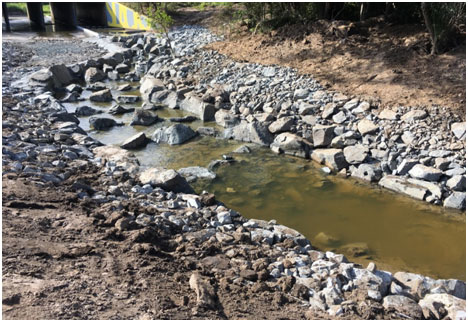
Aquatic connectivity has been restored through the construction of a rock ramp and horizontal culvert baffle fishway on Slacks Creek just south of Brisbane in the Logan River Catchment (Figure 1). The construction of the fishway was a collaborative effort between Logan City Council and the Federal Government who helped fund the project and fish passage specialists Catchment Solutions who designed and constructed the fishway.
Fish passage blocked
The Paradise Road culverts had been blocking fish passage along Slacks Creek for many years due to a 1.8 m high barrier, consisting of 1.3 m water surface drop barrier on the downstream side of the concrete apron combined with velocity and shallow water depth barriers throughout the 50 m long culverts which comprised a 500 mm longitudinal cross fall. The recently constructed fishway (July 2017) will enable many economically important fish species such as Australian bass, jungle perch, sea mullet and long-fin eels the opportunity to migrate upstream, improving the health and resilience of Slacks Creek.
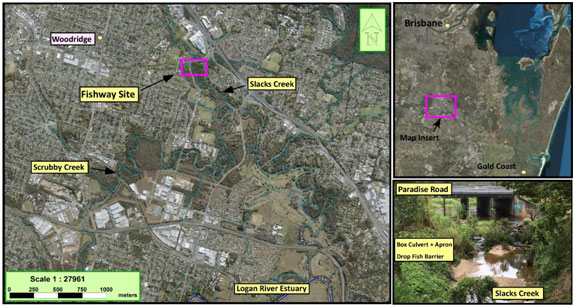 Figure 1. Showing location of the Paradise Road fish barrier on Slacks Creek in Logan City, South-east Queensland.
Figure 1. Showing location of the Paradise Road fish barrier on Slacks Creek in Logan City, South-east Queensland.
Two fishway designs were required to restore fish passage past the Paradise Road culverts, including a 17 ridge nature-like rock ramp fishway on the downstream side of the culvert apron (Figure 2). The rock ramp fishway remediated the vertical water surface drop barrier through the creation of 17 pools interspersed by rock ridges, each 80 mm higher than the previous one, forming a set of ‘underwater stairs’. Native fish, particularly small bodied and juvenile fish are really poor swimmers, only able to travel fast (burst speed) through high velocities for short distances, before having to rest and regain their energy. Furthermore, unlike their northern Hemisphere cousins; Atlantic Salmon, native fish don’t possess the same ability to ‘leap’ when undertaking upstream migrations.
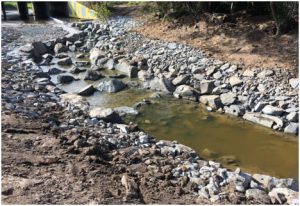 Figure 2. Slacks Creek 17 ridge nature-like rock ramp fishway
Figure 2. Slacks Creek 17 ridge nature-like rock ramp fishway
Rock ramp fishways emulate natural riffles with the added benefit of deep (0.5 m) resting pools spaced out at approximately 2 m intervals. The rock ridges separate each pool and are constructed using a laser level and excavator to place large 2-4 tonne (1.2 – 1.6 m) rocks into precise positions, leaving small gaps (slots) between the rocks which fish use to swim through. In total 765 tonne of rock was used to form the Slacks Creek nature-like rock ramp fishway, including rocks as large as 2.5 m³ and weighing up to 11 tonne each. Using large rock ensures sufficient pool depths are maintained which in-turn reduces turbulence and water velocity and creates crucial resting areas (Figure 3). To ensure the fishway operated during low flows, fibre re-enforced concrete was pumped into the fishway to seal the pools and provide additional structural support.
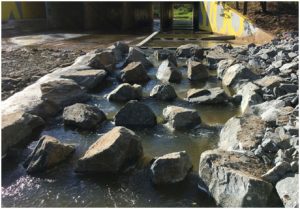 Figure 3. Showing fishway pools with 80 mm drops between rock ridges.
Figure 3. Showing fishway pools with 80 mm drops between rock ridges.
The rock ramp fishway provides fish passage up to and over the 1.3 m water surface drop off the downstream side of the Paradise Road culverts, however, the provision of fish passage through and past the culverts required a different fishway solution. The culvert configuration on Paradise Road consists of four 3.5 wide by 3.6 m high box culverts and a longitudinal cross fall of 500 mm. The total culvert aperture is approximately four times the width of the natural creek channel. The additional aperture of the culverts in comparison to the natural creek channel creates a shallow film of water (<40 mm) throughout the culverts during low flow conditions, creating a shallow water surface barrier. During medium flow conditions, the 500 mm longitudinal cross fall coupled with the smooth internal surfaces creates a water velocity barrier. From 2013-2016 low and medium flows contributed 75% off all stream flow down Slacks Creek.
Slacks Creek is surrounded by urban and industrial landuse, creating a catchment with impermeable surfaces, high runoff rates and occasional flooding. Stream flow conveyance through the culverts was a major design consideration. Hydraulic modelling was required to demonstrate that the fish passage design caused ‘no net worsening’ of inundation levels during storm events. The solution to the flooding, shallow water surface and velocity barriers was the development of a series of horizontal concrete baffles constructed in-situ within the outside culvert barrel (Figure 4).
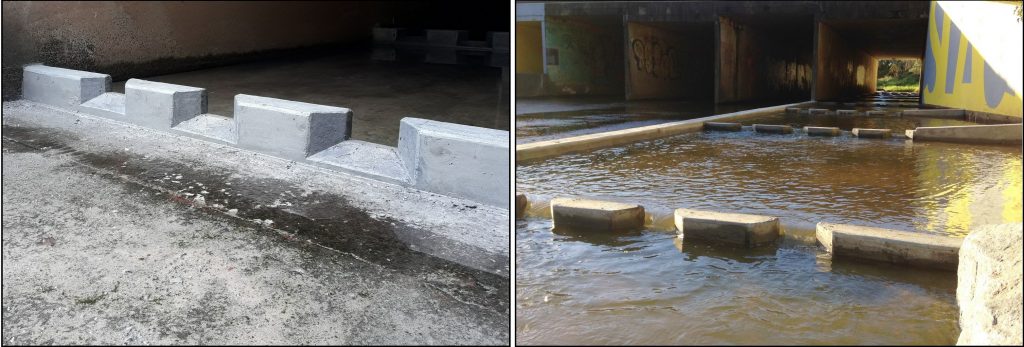 Figure 4. Showing recently poured horizontal concrete baffles (left) and in flow showing 50 mm drops. Note nib wall on left hand side constructed to divert attraction flows through the fishway.
Figure 4. Showing recently poured horizontal concrete baffles (left) and in flow showing 50 mm drops. Note nib wall on left hand side constructed to divert attraction flows through the fishway.
The baffles were designed to slow down the velocity, reduce turbulence and increase the water depth within the culverts. Importantly, the baffles still allowed for the conveyance of stream flows with minimal reduction in culvert capacity. In total ten concrete baffles each 200 mm high x 150 mm wide were fixed to the invert of outside culvert barrel. Concrete nib and wing walls were constructed on the upstream and downstream sides of the culverts to divert low and medium attraction flows through the fishway. Baffles were spaced at 5 m intervals creating 50 mm drops between pools. Four fish passage ‘slots’ were created within each baffle by inserting blank timber molds, before each baffle was poured with concrete. Two high flow and two low flow slots were incorporated into the baffle design to increase the operational range of the fish passage design. Slots in each subsequent concrete baffle were offset to minimise the water ‘jetting’ affect. The outcome of the horizontal concrete baffle configuration is the creation of large pools that fish can use to rest and regain their energy, enabling them to successfully ascend the 50 m long culverts, while also maintaining flood conveyance throughout the culverts.
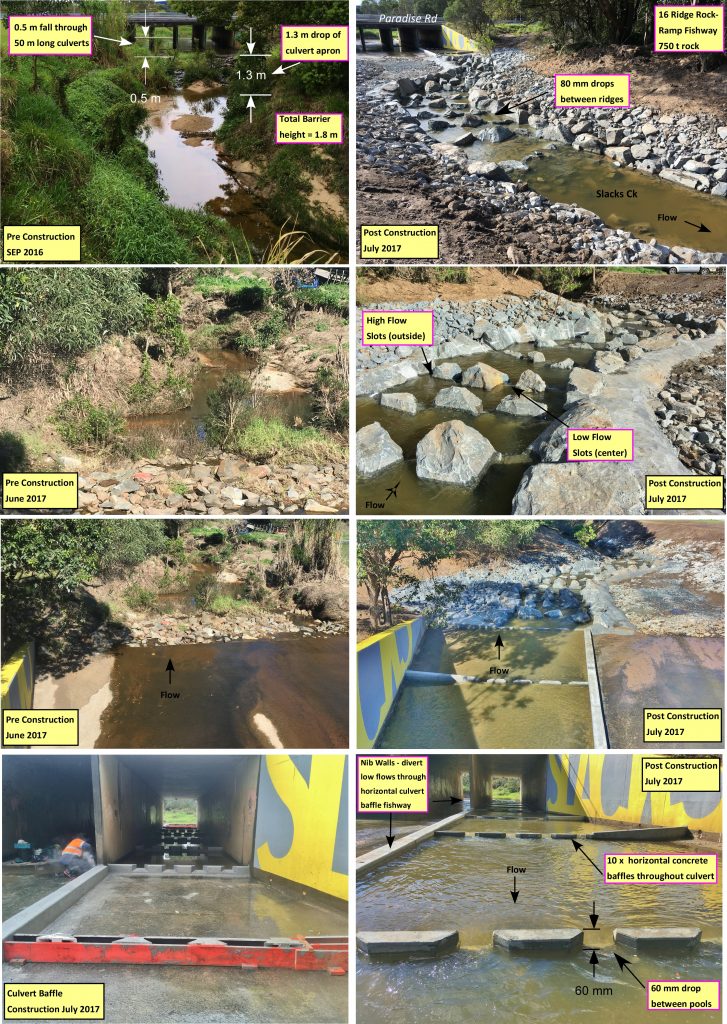 Figure 5. Showing Pre and post Slacks Creek fishway construction.
Figure 5. Showing Pre and post Slacks Creek fishway construction.